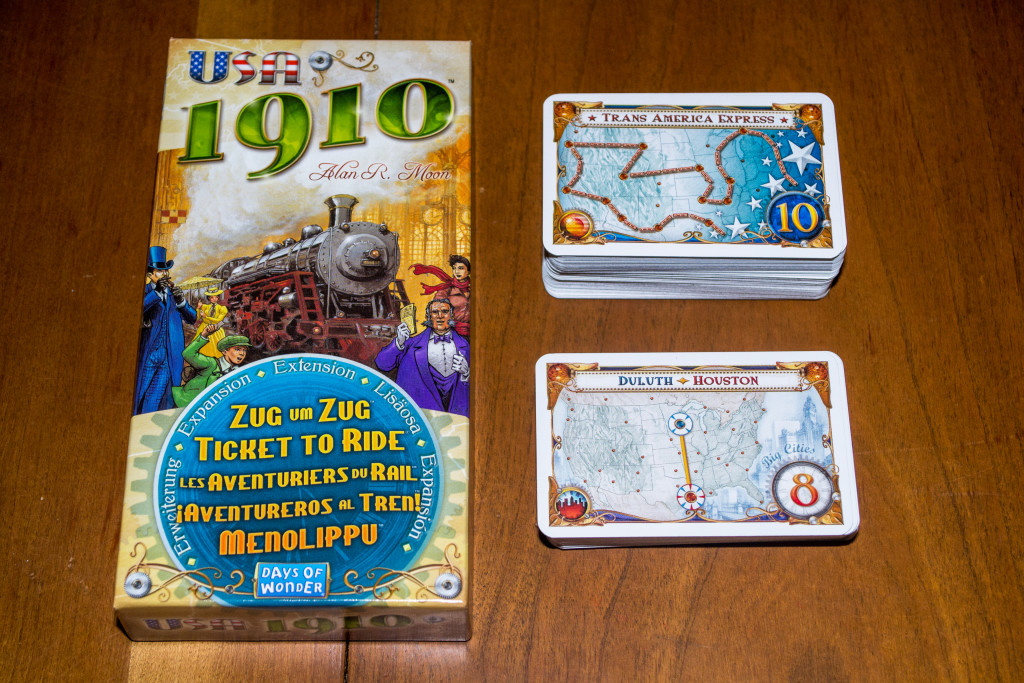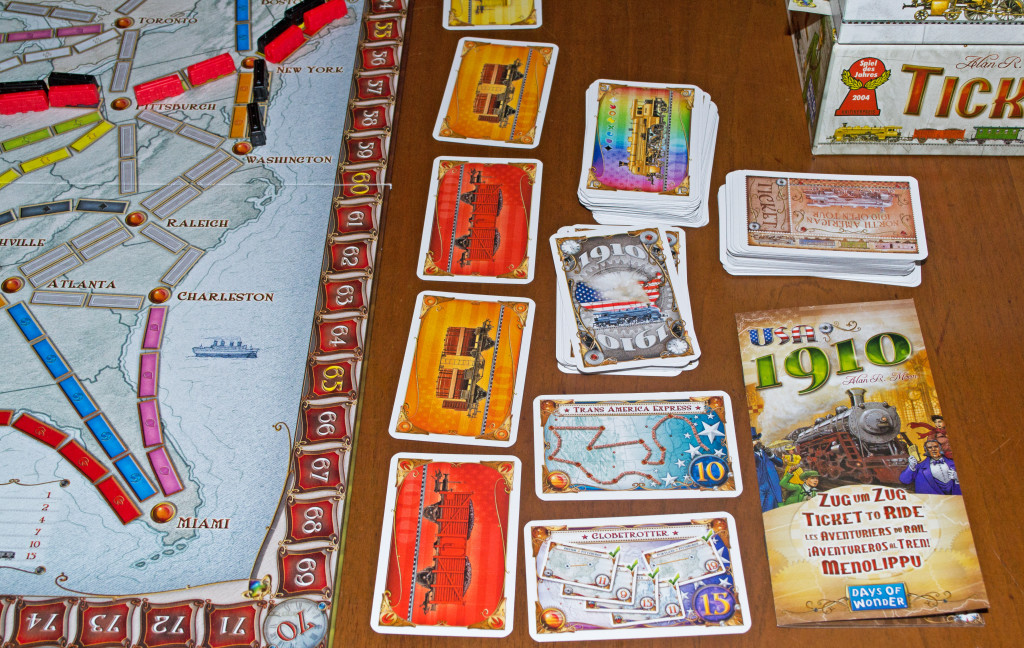Whether you’re playing “Ticket to Ride” or its video game adaptation, you’re in for a good time. It’s one of the most commonly played board games in my household and for good reason…it’s family-friendly and incredibly fun. This is one of the reasons I decided to splurge a bit and pick up the “USA 1910” expansion as it promised to introduce some new things to help give the base game a little oomph. Since I’ve already reviewed the base game, I’ll opt to simply go over what came in the expansion and what I thought of it as a whole. If you’re interested in learning more about “Ticket to Ride” in general, go check out my reviews linked above.
Components
The expansion includes:
1). Large format reprints of all the cards from the original deck. In other words, the ticket, train, and bonus cards are bigger. Four of the tickets have been revised, their values being adjusted downward.
2) Thirty-five new destination tickets (there is a “1910” logo in the upper right corner to distinguish them from the originals, as well as four destination tickets from the out-of-print Mystery Train expansion originally released at the 2004 Essen Fair.
3. One new fifteen point Globetrotter bonus card for the most completed tickets.
Variants
Players can opt to use any of these new variants (taken directly from the rulebook):
1910 – Play as per the standard rules, using only the new tickets with the 1910 logo in the upper right corner instead of the standard ones. Replace the Longest Route Bonus card with the new Globetrotter – Most Completed Tickets bonus card.
The Mega Game – Both bonus cards are in play. Shuffle all 69 tickets and deal 5 tickets to each player at game’s start; keep at least 3 (and up to all 5 if you dare!). During the game, whenever you choose to draw tickets, draw 4 and keep at least 1. Discarded tickets always go back to the bottom of the tickets draw pile.
The Big Cities – Use all tickets that feature at least one Big City (cities on tickets are printed in red). The Big Cities are Chicago, Dallas, Houston, Los Angeles, Miami, New York and Seattle. There are 35 such tickets, 15 from the original set and 20 new ones, including one from the Mystery Train expansion. At game’s start, shuffle the Big Cities tickets and deal 4 to each player; each must keep at least 2 (or more if they feel brave!). During the game, whenever you choose to draw tickets, draw 4 and keep at least 1. Discarded tickets always go back to the bottom of the tickets draw pile.
The Review
My initial thoughts were something along the lines of, “$20 for some new/bigger cards!? I could just buy a new game for that price!” In all honesty, that’s what has kept me from buying the expansion up to this point…it just so happened that I had a little extra left over from Christmas shopping. We play the base game so much that we can sometimes guess what a player has in terms of tickets after one or two routes…this can take the mystery and fun out of playing. The new ticket cards will help to prevent that from happening again any time soon, especially if you utilize all of them via “The Mega Game” variant. There are a lot of shorter ticket routes (one is even worth two points) so now I don’t feel as hesitant to draw tickets during the game for fear that I’d never be able to complete them in time. The Globetrotter bonus is also a nice touch.
What’s nice about “Ticket to Ride” is that it is flexible enough to where you can make up your own variants. You could, for example, use all the ticket cards but only draw three in the beginning (as normal) instead of four. You can opt to use only the tickets with a value of “X” or lower/higher, giving you a game of all short or long routes, respectively. You could also opt to include all, some, or none of the bonus cards…you get the idea. This expansion simply gives you more ways to customize your game, which is a plus for any hardcore “Ticket to Ride” fan.
The larger cards are indeed nice to have and do fit in the original insert with a little organization and thought, though the expansion box will not (not without mutilating and removing the insert’s separators). They are also easier to handle and shuffle. Is it worth $20 though? It depends. If you and your family/gaming group play “Ticket to Ride” religiously, then I’d say yes. If you bring out “Ticket to Ride” once in an Alan R. Moon (ba-dum-ch!!), then I’d say no. The base game is perfectly playable by itself and can easily provide entertainment for years to come…most casual gamers can and will be happy with just that. With that said, sometimes you just want more. I personally would have liked another train set so that six players could play or something along those lines, but I suppose “USA 1910” does the job as-is even if it is a tad on the expensive side.
Final Verdict: 7/10
—



Maybe you can answer this for me as I have been unable to find it on instructions or online. If when playing 1910 expansion game with “longest road” and “most cards completed” options used…,,who wins if 2 players each finish with the same amount of tickets? Or in our most recent situation, one person had longest road and the other 2 had completed 5 cards?
Follow the “Calculating Scores” on the last page of the original game.
1) count the points based on the trains played.
2) add the points for each trip ticket completed or subtract for the trip tickets not completed.
3) count number of completed tickets. Most gets 15. If a tie, both get 15.
4) longest continuous path gets 10. If a tie for longest path, both get 10.
5) person with most points wins. If there’s a tie for points, most tickets wins. If still a tie for points, the longest path wins.
Good